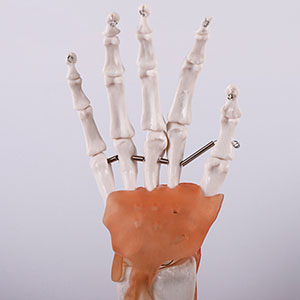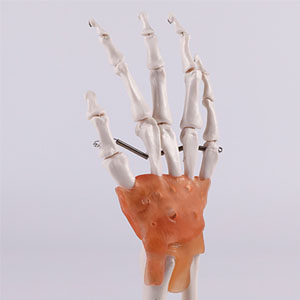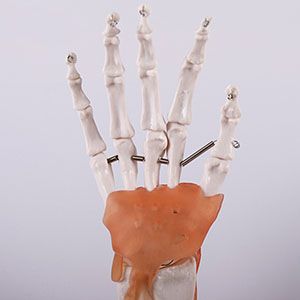In medical education and clinical training, the anatomy and function of the joint of the hand is often regarded as complex and difficult to master. In order to better meet the dual needs of teaching and clinic, the high simulation tool of hand joint model ligaments has been widely used. This paper will discuss the role and value of this model in teaching and clinical practice from the perspective of medical students' learning, combined with actual cases and data.

1. Real reproduction of complex anatomical structures
The most important feature of the hand joint model ligaments is precise detail and comprehensive structure. It not only shows the arrangement of the bones in the hand, but also restores the distribution and attachment points of the ligaments in detail, helping students to understand the interaction between bone and ligament.
In the course of teaching, students are often confused about the three-dimensional spatial relationship of hand anatomy. Studies have shown that the use of highly simulated models can significantly improve students' understanding of complex anatomical structures. According to Advances in Anatomy Education (2022), 86% of medical students believe that model teaching is more intuitive and easier to remember than traditional anatomical maps.
For example, in an experiment at a medical school, researchers divided students into two groups: one group learned using a model of a hand joint with ligaments, and the other group only used anatomical maps. The results showed that the former improved the accuracy of structure recognition in the exam by 28 percent.

2. Practical value in clinical training
For clinical training, hand joint models with ligaments provide an opportunity to approach real-world manipulation. It helps students and junior doctors understand how ligament injuries occur and how to perform repair surgery. For example, when studying ligament tears or joint dislocation, the model can demonstrate the anatomical manifestations of these pathological changes, thereby improving students' ability to respond to clinical cases.
A typical case comes from a hand surgery training center in the United States. Using a model of the hand joint, the center has designed a course for novice doctors that simulates arthroscopic operations. At the end of the training, the doctors' familiarity with the surgical equipment and practical skills improved, with a 15 percent increase in the success rate of the model group.
In addition, the flexibility of the model allows it to be used for training in different areas, such as:
- Orthopaedic surgery: provides visual reference for surgical planning.
- Rehabilitation Medicine: Help physiotherapists design targeted training programs.
4. Market potential and development direction of the model
With the increasing demand for medical education, the hand joint model market is showing a steady growth trend. According to data from market Research firm Grand View Research, the global medical education model market will reach $1.8 billion in 2023, of which hand models will account for about 12%. In the future, with the continuous progress of technology, the model will have more breakthroughs in the degree of simulation and interaction, such as:
- Smart sensors: capable of capturing operational data and providing real-time feedback on the learner's actions.
- Modular design: Students can disassemble certain parts individually for detailed study.
conclusion
The model ligaments of hand joints play an important role in the teaching and clinical training of medical students because of their high simulation and practicability. By visually demonstrating complex structures, supporting practical operations and complementing traditional teaching resources, this model has become an important tool for training future medical talents.
For medical educators, making full use of the advantages of hand joint model ligaments can not only help students quickly master anatomical knowledge, but also improve their practical application ability in clinical practice. This is not only a teaching tool, but also a strong guarantee for improving the quality of education.

